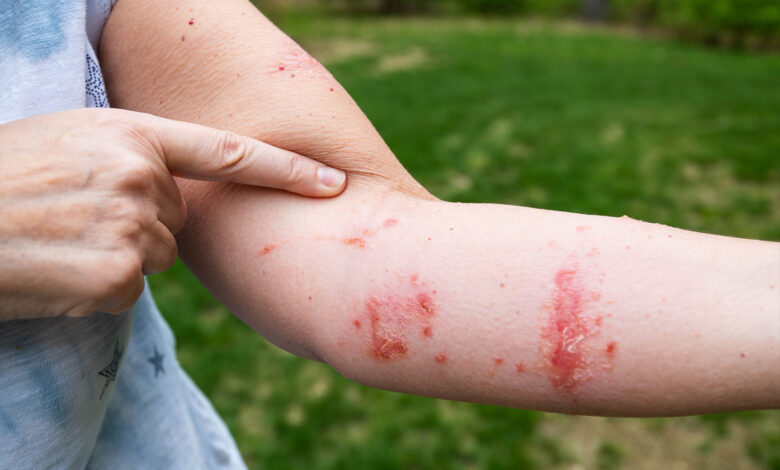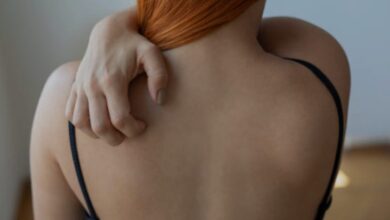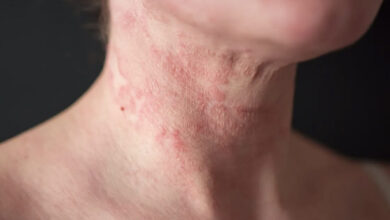POISON IVY: A Miserable Rash!

“Leaves of three, let them be!” You’ve probably heard that expression; especially if you live in Indiana. It’s the colloquial warning against coming in contact with one of the most annoying and irritating plants man and animal encounter-POISON IVY. It’s a nightmare. This “plant” exists as a climbing vine in the south, east, and midwest, and as a shrub in the Great Lakes region and northern and western states. It seems to grow in abundance along fencerows and creek beds. I know. I experienced its wrath many many summers when I encountered it while removing weeds from my yard or hunting for an errant golf ball near a water hazard. Supposedly, it’s easy to recognize, but you never know because it hides behind other vegetation and grabs you unsuspectingly. And you don’t know it’s gotten you until a day or two later. I hate it!
Poison Ivy is one of the many varieties of contact dermatitis meaning the plant has come in contact with your skin leaving behind an oily resin that causes an an allergic reaction in the form of an itchy, red, blistery rash. There are many other kinds of contact dermatitis, but poison ivy is one of the most bothersome. This oily resin called URUSHIOL, is found on the leaves, stems, and roots of the plant. When urushiol comes in contact with your skin, it is absorbed in varying amounts depending on how long the plant is in contact with your skin and how much of the exposed resin gets absorbed. Anywhere from 4 hours to 48 hours after contact, the rash develops. There have been reports of delays in outbreak of up to 10 days.
Not only does the oily resin get on your skin, but it gets on your clothes, your shoes, your garden tools, golf clubs, and your pet’s fur because it is sticky and adheres easily. And if you don’t thoroughly wash those items after exposure it can stay there and be effective for up to FIVE YEARS. Ye gods! No wonder it keeps coming back. Those athletic shoes and their shoestrings, that you rarely wash, are continually re-exposing you to the resin, and so you get poison ivy repeatedly. How aggravating.
Those weeds that you pull and burn may contain poison ivy, too, so the smoke from the fire will contain urushiol. If it does, and you inhale some of it, serious allergic reactions of the nasal and bronchial airways, and lungs, are possible. The airways swell and become blocked causing difficulty breathing and rarely, death.
Most of us have seen the rash of poison ivy. It is raised, red, sometimes blistery, and VERY ITCHY. It forms patches, dots, or streaks depending what mode of contact occurred. Classically, the rash is streaked where the leaves brushed against the skin so seeing that streaky pattern makes it easy to diagnose. The rash is NOT CONTAGIOUS, and the FLUID IN THE BLISTERS DOES NOT SPREAD IT. The fluid in the blisters is material that seeps from affected cells and is serum, the liquid part of blood. The rash doesn’t break out all at the same time because it depends upon the amount of resin on the skin and the duration of contact. So the more resin on the skin for long periods of time the sooner the rash develops and the worse it is. Scratching the rash doesn’t spread it, but it does worsen the swelling and local reaction from the trauma and irritation of scratching. And if the rash comes back later, you’ve re-contacted some of the resin remaining on your shoes, clothing, tools, or pet.
It’s a tricky, devilish condition. The best thing to do is learn to recognize the plant and stay away from it. Don’t get exposed in the first place. But when you do get it, cortisone pills, shots, and cream will shorten the duration and help the itching. Untreated, poison ivy lasts 3-6 weeks (yikes!). Treatment can shorten that to 10-14 days if you’re lucky. Itching can be helped by H1 (anti-histamines like Benadryl or Atarax) and H2 blockers (like cimetidine or ranitidine). Unfortunately, treatment is only slightly effective so you have to be patient. Sometimes, though, treatment will help in 10-14 days. Calamine lotion, Ivy Dry, Aveeno “oatmeal” baths, and cold wet compresses don’t clear the rash but may lessen the itching.
One important preventive measure is to wash your skin thoroughly as soon after contact as possible. Thirty minutes after contact is the optimal time to take a shower and scrub-a-dub-dub. If you can’t shower that soon, do it ASAP because you’ll shorten the length of time the resin is on your skin and lessen the severity of the rash. Also be sure to thoroughly launder your clothing, and clean the shoes, tools, clubs, etc. that were in contact with the plant.
Poison Ivy is not a condition to which one develops immunity. It’s not like chicken pox. You can get it again anytime you contact the plants. Some lucky folks never get it and seem to be resistant to its charm, but somewhere along life’s path they will probably experience its wrath.
Dr. G’s Opinion: For 27 years we lived near a wooded area. Every spring I pulled, cut and trimmed weeds along a fencerow and by a huge oak tree. Many of those 27 years I got poison ivy. No matter how careful I was to avoid it, I still got it. My impatience and discomfort didn’t help because it itched so badly I made it worse. Multiple shots of Depo Medrol, application of betemethasone cream, and oral hydroxyzine failed to resolve it fast enough for my satisfaction. So my episodes lasted on the higher end of the length scale. My very best advice to you is stay away from anything that looks suspicious. Remember, “LEAVES OF THREE, LET THEM BE!”
References: outsideonline.com/poison-ivy



